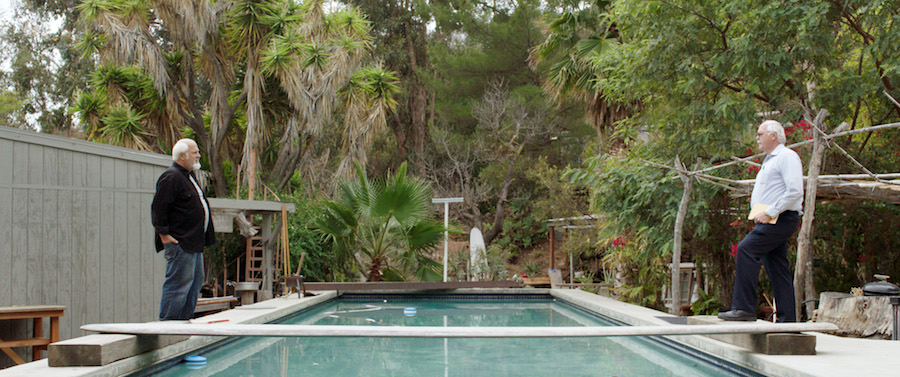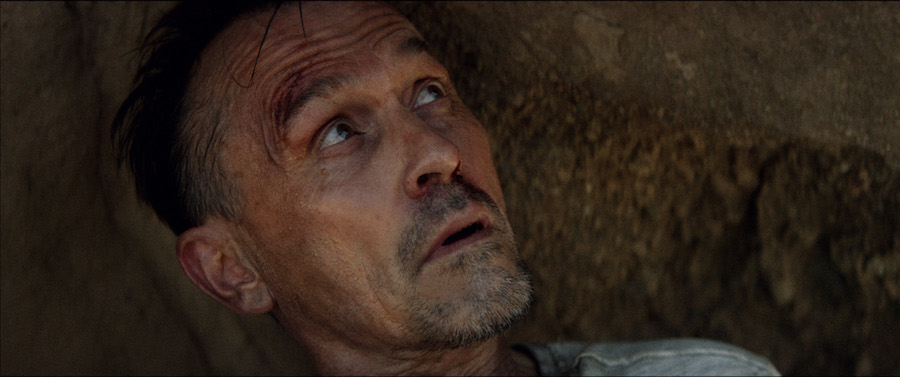[nemus_slider id=”60872″]
English text below
Lo Schermo dell’Arte film festival, a Firenze dal 16 al 20 novembre, aprirà con il film Where Is Rocky II? di Pierre Bismuth (Francia, Germania, Belgio, Italia, 2016, 90′) presso il Cinema La Compagnia di Firenze, il 16 novembre 2016 alle ore 21. Il film, una riflessione sulla natura del film documentario e di finzione, sul lavoro di sceneggiatura, sulla forza espressiva dell’arte, trasporta gli spettatori in un vortice di continuo distacco e avvicinamento alla realtà, dove anche la colonna sonora risulta fondamentale.
ATP: Where Is Rocky II?, il tuo primo film da regista, è la cronaca di “un’ossessione”, in cui ingaggi un detective privato – Michael Scott – per trovare Rocky II, un finto masso in resina realizzato dall’artista americano Ed Ruscha, nascosto dall’autore tra le vere rocce nel deserto del Mojave in California nel 1979. Come mai hai voluto girare un film su questo?
Pierre Bismuth: Ho anche ingaggiato un team di sceneggiatori di Hollywood, ed è interessante che tu veda “un’ossessione” dove io vedo principalmente persone al lavoro. Tanti professionisti impegnati a risolvere un problema con la loro esperienza sul campo. E il tutto è abbastanza rilassato, non ossessivo, perché non bisogna dimenticare che stiamo parlando di Los Angeles, e a Los Angeles si è sempre rilassati e tranquilli. In ogni caso, la ragione per cui ho voluto fare questo film è che ho pensato fosse una grande occasione quella di provare qualcosa di nuovo, lavorando sui diversi registri di realtà normalmente previsti da film e televisione. Sperimentare con queste nozioni, cercando di ribaltare i protocolli usuali. L’idea era di nascondere la realtà nella finzione e produrre quello che io chiamo “fake-fiction”: un film che segua i metodi documentari per raccontare una storia vera e non sceneggiata, ma che sia girata e montata in tal modo da poter essere percepita come romanzata.
ATP: Mentre Rocky II di Ruscha vive il conflitto tra la sua esistenza e la sua paradossale non esistenza, Where Is Rocky II? è un progetto artistico, un documentario e un film di finzione che trova significato nel conflitto tra generi cinematografici muovendosi costantemente tra questi. Vorresti spiegarci questo mix di generi?
PB: Di nuovo mi pare tu veda una tensione dove io vedo una liberazione. Il lavoro di Ed Ruscha tratta il lasciarsi andare: l’opera è letteralmente abbandonata nel deserto con una totale assenza di controllo. La stessa dinamica è applicata al film, cominciando dal non avere una sceneggiatura e seguendo qualsiasi direzione ci suggerisse il caso mentre stavamo girando. Abbiamo iniziato come un documentario ma con l’idea che avremmo potuto cambiare strada durante il processo. Abbiamo cercato di fare un film che potesse muoversi organicamente da una cosa a un’altra senza imporci un’idea prestabilita del modo in cui questo film avrebbe dovuto presentarsi alla fine.
ATP: Nel 2005 hai visto l’Oscar per la miglior sceneggiatura originale del film “Eternal Sunshine of the Spotless Mind” di Michel Gondry. Questa esperienza è legata con la presenza dei tre sceneggiatori di Los Angeles – DV Devincentis, Anthony Peckham, Mike White – e il loro processo di scrittura che riproponi nel film?
PB: Sono sempre stato interessato al lavoro dello sceneggiatore. Amo l’idea che il film possa essere racchiuso in 100 pagine e adoro seguire i processi creativi delle persone, come un’idea porta a un’altra idea e come il significato sia costruito pezzo per pezzo. L’idea di avere tre sceneggiatori è partita con l’intento di creare situazioni che avrebbero prodotto dei dialoghi. Questo è l’unico modo a cui ho pensato per mostrare i processi creativi degli scrittori.
ATP: La musica sembra essere molto importante nei tuoi film. Come mai?
PB: Direi che è addirittura fondamentale. In primis è perché sono sempre stato interessato alla musica, anche prima di iniziare a lavorare con le arti visive e i film. Ma in questo caso avere una composizione originale era una necessità, per produrre una “fake-ficiton”. La musica e l’arte dell’editing sono ciò che da la sensazione che tutto succeda per un motivo, trasformando una serie di eventi contingenti e imprevisti in qualcosa che potrebbe apparire costruito e predeterminato.


Interview with Pierre Bismuth — Lo Schermo dell’Arte, Firenze
Lo Schermo dell’Arte film festival, in Florence from 16 to 20 November, 2016, will open with the movie Where Is Rocky II? by Pierre Bismuth (France, Germany, Belgium, Italy, 2016, 90′) at Cinema La Compagnia in Florence, on November 16th, 2016, 9 pm. The movie, a thought on documentary and fiction film nature, on the work of screenplay writing, on the expressive force of art, carries the viewers in a swirl of continuous parting and approach to reality, where the soundtrack also becomes fundamental.
ATP: Where Is Rocky II?, your first film as director, is the chronicle of “an obsession”, in which you hire a private detective – Michael Scott – to find Rocky II, a fake boulder in resin by American artist Ed Ruscha, hidden by its author among real rocks in the Mojave Desert in California in 1979. Why did you want to make a movie about this?
Pierre Bismuth: I also hire a team of Hollywood screenwriters, and it is actually interesting that you see “obsession” where I mainly see people at work. Different professionals busy at resolving a problem within their field of expertise. And quite relaxed / not obsessive about it, because you shouldn’t forget this is LA and LA is very much about being cool and laid-back. But anyway, the reason I wanted to do the film is because I felt it was a good opportunity to try something new, elaborating on the different regimes of reality usually provided by film and television. Experimenting with these notions, trying to reverse the usual protocols. The idea was to hide reality into fiction and to produce what I call a “fake –fiction” : a film that follows documentary methods to tell a real and unscripted story, but that is shot and edited in such a way that it can be perceived as fiction.
ATP: While Rocky II by Ruscha lives the conflict between its existence and its paradoxical nonexistence, Where Is Rocky II? is an art project, a documentary and a fiction film that finds meaning in the conflict between genres by constantly moving between them. Would you like to explain us this genres mix?
PB: Again you seem to see tension where I see liberation. Ed Ruscha’s piece is about loosening up: his piece is literally abandoned in the desert with a total absence of control. The same dynamic is applied to the film, starting with no script and following whatever direction the shoot would take us.
We started as a documentary but with the idea we would let ourselves lose our path in the process. Trying to do a film that would organically move from one thing to another without imposing a pre-established idea of the way the film should be in the end.
ATP: In 2005 you won the best original screenplay Academy Award for the film “Eternal Sunshine of the Spotless Mind” by Michael Gondry. Is this experience related with the presence of the three LA screenwriters – DV Devincentis, Anthony Peckham, Mike White -, and their writing process you captured in the film?
PB: I have been always interested in the screenwriter’s job. I love the idea that a film can be encapsulated in a 100 pages and I love to follow someone’s creative process. How one idea leads to another and how meaning is constructed bit by bit. The idea of having 3 screenwriters was mainly to create situations that would produce dialogues. That was the only way I though of to show the writers creative process.
ATP: Music also seems to be very important in your movie. Why?
PB: I would even say fundamental here. First I have always been interested in music, even before I had been involved in visual art and films. But here music and having an original composition was a necessity to produce the “fake-fiction”. The music and the art of editing is what gives the feeling that everything happens for a reason, transforming a series of unscripted contingent events, into something that would look constructed and predetermined.











